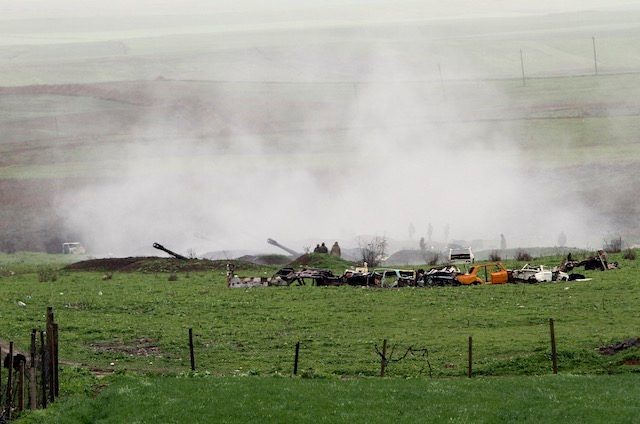SUMMARY
This is AI generated summarization, which may have errors. For context, always refer to the full article.

STEPANAKERT, Azerbaijan (3rd UPDATE) – Clashes between Azerbaijani and Armenian forces killed at least 13 people Monday, April 4, in a third day of fighting over Nagorno-Karabakh, as Turkey fueled tensions following the worst violence in decades in the disputed territory.
Russia and the West have scrambled to call for an end to the fighting, but Turkish President Recep Tayyip Erdogan, a firm ally of Azerbaijan, insisted that the Armenian-controlled region would “one day” return to Baku’s control.
On the ground, the death toll since fighting erupted on Friday night, April 1, rose to 46 after Armenia’s defense ministry said 5 Armenian “volunteer” fighters were killed when a bus in which they were traveling was hit.
Earlier the Armenia-backed separatist authorities in Karabakh – which claims independence but is supported by Yerevan – said 3 civilians and two more soldiers were killed in fierce shelling.
Baku said 3 of its troops were killed overnight when Armenian forces shelled its positions using mortars and grenade launchers.
Azerbaijan has claimed to have captured several strategic positions inside Karabakh, which is internationally recognized as part of Azerbaijan, in what would be the first change in the frontline since an inconclusive ceasefire ended a war over the region in 1994.
Armenian President Serzh Sarkisian said a “ceasefire would only be possible if the militaries of both sides return to the positions” they held prior to the outbreak of hostilities.
His comment came a day after Azerbaijan announced a unilateral truce that failed to stop the fighting.
Azerbaijan’s Defence Minister Zakir Gasanov instead ordered the army Monday to be ready to strike Karabakh’s capital Stepanakert “in case of continued Armenian bombardment of civilian targets in Azerbaijan.”
An Agence France-Presse photographer in Stepanakert said the situation remained calm on Monday in the rebel capital with a population of around 50,000 people.
Hundreds of volunteers were arriving in the city from Armenia to fight alongside separatist forces, while local authorities were busy organizing shelters for the refugees from frontline villages.
Erdogan backs Baku
President Vladimir Putin of Russia, which has sold weaponry to both sides but has far closer economic and military ties to Armenia, has called for a ceasefire, a move echoed by Washington.
But Erdogan – another regional power broker who has been at loggerheads with Putin since Ankara downed a Russian warplane near the Syrian border in November – fanned the flames.
“We are today standing side-by-side with our brothers in Azerbaijan. But this persecution will not continue forever,” Erdogan said in televised comments.
“Karabakh will one day return to its original owner. It will be Azerbaijan’s”.
Russian Foreign Minister Sergei Lavrov and US Secretary of State John Kerry discussed Karabakh in a phone conversation on Monday, Russia’s foreign ministry said.
In an apparent reference to Erdogan’s statement, the ministry said: “Lavrov and Kerry condemned attempts by certain external players to instigate confrontation around Karabakh.”
State Department spokesman Mark Toner did not address Erdogan’s remarks, but said both sides should resume the internationally mediated search for a settlement.
He deplored the “very high number of casualties, including civilians.”
“And we urge both sides to stop using force immediately and to avoid any kind of further escalation,” Toner added.
Mediators from Russia, the United States and France – which have long spearheaded attempts to find a solution to the “frozen” conflict – are to meet in Vienna on Tuesday, April 5.
‘Geopolitical implications’
Separatists backed by Yerevan seized control of mountainous Nagorno-Karabakh, a majority ethnic Armenian region, in an early 1990s war that claimed some 30,000 lives. The foes have never signed a peace deal despite the 1994 ceasefire.
Energy-rich Azerbaijan, whose military spending exceeds Armenia’s entire state budget, has repeatedly threatened to take back the breakaway region by force.
Sporadic clashes happen regularly along the front but the latest outbreak represents a serious escalation and analysts warned it risked spiraling even further.
“The Karabakh conflict has serious geopolitical implications,” Sergi Kapanadze, a professor of international relations at the Tbilisi State University, told Agence Frane-Presse.
The flare-up “threatens the stability of the strategic Caucasus region which is a transit route of Caspian oil and gas to European markets that bypasses Russia, reducing Europe’s dependence on Russian energy supplies,” he said. – Karen Minasian with Emil Guliyev in Baku and Mariam Harutyunyan in Yerevan, Armenia, AFP / Rappler.com
Add a comment
How does this make you feel?
There are no comments yet. Add your comment to start the conversation.